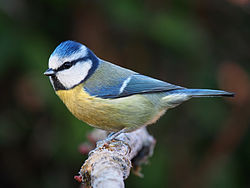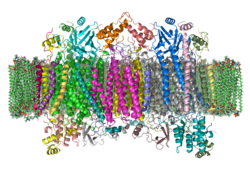Species
A species is a kind of organism. It is a basic unit of biological classification, and a formal rank in taxonomy. Originally, the word was used informally in a rather vague way, but now there are at least 26 different ways it is used.[1]
All animals or plants that are the same kind belong to the same species. Wolves (Canis lupus) are one species. Humans (Homo sapiens) are another species. Broadly, the idea is that, for example, cats breed with cats and produce more cats. This is the basis for deciding to have a species called Felis catus. However, to give a simple definition of 'species' is difficult, and many people have tried.[2]
Species is a word for a particular kind of living thing, for example, a jackdaw. Jackdaws and ravens are similar, so they are together in a larger group (taxon) called a genus, in this case Corvus. Then there is a family (such as the crow family, which includes crows and ravens as well as jays and magpies). Families are put together into orders such as the songbirds, which includes many families of birds. The next group is the class; all birds are in the same class. After that is the phylum, such as vertebrates, which is all animals with backbones. Last of all is the kingdom, like the animal kingdom. These are ways to classify living things.
There is a mnemonic to help people remember the order of the divisions which are listed again below: "King Phillip Came Over For Great Spaghetti".
Example
Take as an example the bird called a Common Loon or Great Northern Diver:
Historical changes in the term
There is a long history of disagreement over whether species are objective things, or whether they are man-made labels. Those who think species are objectively different point to things which 'good' species do. They look similar, and they breed true, that is, mate with their own kind, and have offspring which are obviously in the same species.
Against this are the many exceptions. There are species which shade gradually into other species, and which interbreed in overlapping populations (see ring species). On the other hand, there are species which look absolutely identical, but which do not breed together (sibling species).[3]
It is quite clear that 'species' as used by palaeontologists and 'species' as used by other biologists cannot be the same. A palaeontologist can only use visible features of a fossil, which are only a small part of the traits of a living species. Not only that, but many species which are virtually identical can only be distinguished by their DNA. This relatively recent discovery of sibling species is very important, and their numbers are growing rapidly. We underestimated the effect of convergent evolution.
The greatest change in the species concept was made by Charles Darwin, for evolution meant that hard-and-fast lines could not be drawn between species. Another shift came when Ernst Mayr proposed the biological species concept, which emphasized the interbreeding population as the heart of the species concept. This meant that, in his view, species were objective, that is not just the subjective opinion of a taxonomist. His explanation of the process of speciation was geographical isolation between populations which had once been interbreeding. Today, emphasis has moved back closer to Darwin's ideas.[4][5]
Numbers
According to the most recent estimate,[6] there are about 8.7 million species on Earth. This counts only eukaryote organisms. It leaves out bacteria, archaea and viruses.
Fewer than a quarter of the species have not been identified, named and catalogued. At the present rate, it might take over 1000 years to complete this job. Some will become extinct before this count is complete.
Species Media
All adult Eurasian blue tits share the same coloration, unmistakably identifying the morphospecies.
A region of the gene for the cytochrome c oxidase enzyme is used to distinguish species in the Barcode of Life Data Systems database.
The cladistic or phylogenetic species concept is that a species is the smallest lineage which is distinguished by a unique set of either genetic or morphological traits. No claim is made about reproductive isolation, making the concept useful also in palaeontology where only fossil evidence is available.
A chronospecies is defined in a single lineage (solid line) whose morphology changes with time. At some point, palaeontologists judge that enough change has occurred that two species (A and B), separated in time and anatomy, once existed.
Ernst Mayr proposed the widely used Biological Species Concept of reproductive isolation in 1942.
Palaeontologists are limited to morphological evidence when deciding whether fossil life-forms like these Inoceramus bivalves formed a separate species.
A cougar, mountain lion, panther, or puma, among other common names: its scientific name is Puma concolor.
The type specimen (holotype) of Lacerta plica, described by Linnaeus in 1758
Horizontal gene transfers between widely separated species complicate the phylogeny of bacteria.
Related pages
References
- ↑ Wilkins, John 2008. Species concepts in modern literature: summary of 26 species concepts. Reports of NCSE 26 (4). [1] Archived 2012-06-09 at the Wayback Machine
- ↑ Wilkins, John 2006. Species, kinds and evolution. Reports of the National Center for Science Education. 26 (4), 36–45. [2] Archived 2012-01-22 at the Wayback Machine
- ↑ See the beetle Diorhabda, the bug Erythroneura and the marine gastropod Calliostoma.
- ↑ Mallet J. 2001. The speciation revolution. Evolutionary Biology 14, 887.
- ↑ Mallet J. 2005. Speciation in the 21st century (book review). Heredity 95, 105-109. [3]
- ↑ Black, Richard 2011. Species count put at 8.7 million. BBC News Science & Environment. [4]









